| 1 | An Australian swamp menace |
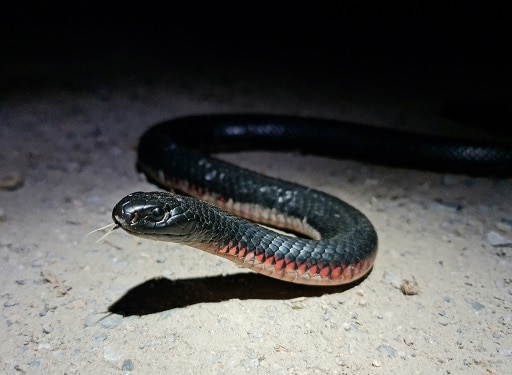
The Australian outback is a place of fear for the vast majority of people who aren’t descended from Crocodile Dundee. It’s not just roastingly hot, but crawling with venomous snakes and wildlife which seemingly forgot to die out during the prehistoric era. Australia has 216 species in total, and within this snake pit, one of the most commonly encountered by ordinary Australians is the red-bellied black snake (Pseudechis porphyriacus).
This snake inhabits a wide range of the country’s east, and accounted for 16% of total snakebites from 2005 to 2015. That’s a ranking of third, behind the brown snake family at 41% and the tiger snake at 17%. Despite being dangerously venomous, and feared by early European settlers, the red-bellied black snake has never been recorded killing anyone.
Red-bellied black snakes appear in Victoria to the south, all the way to central Queensland in the north. On the way, they pass many major cities, including Melbourne, Sydney, Brisbane and Canberra alike.
Most Australians on their daily walks know the telltale signs of this snake: a bright sheen on its back as its dark scales reflect the sunlight, contrasting against a vivid red underbelly which is just visible. The red-bellied black snake is believed to be declining in some regions, but is far from rare, with a rating of “least concern” by IUCN.
| 2 | Looks like a midnight lava flow |
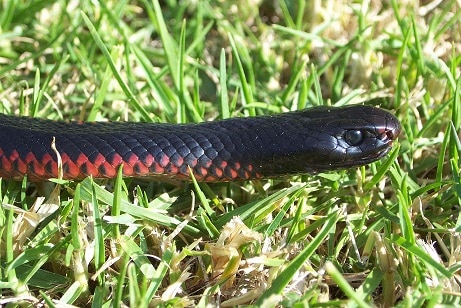
The red-bellied black snake is large though not gigantic, with an all time record length of 254cm. The average is 125cm, significantly longer than the common death adder at 40-80cm, another snake feared by Australian dog walkers.
Red-bellied black snakes have round pupils rather than vertical, and the head barely changes in width from the neck, making the two almost indistinguishable. The most eye catching feature is the red-belly’s volcanic colour scheme. The body is mostly a deep, coal-coloured black, which extends all the way up its head and even to its tongue. This is the sort of all-consuming black that would render it invisible on a starless night. The belly meanwhile, is a soft red colour, deepening to a lava-like red on its lower flanks.
There are no true lookalikes for this snake, except perhaps its cousin the blue-bellied black snake. Hatchlings have the exact same colour scheme as adults. The appearance barely varies across its range, except for two isolated pockets in Queensland, where the local red bellies have a lighter, creamier colour.
| 3 | Australia’s 3rd bitiest snake |
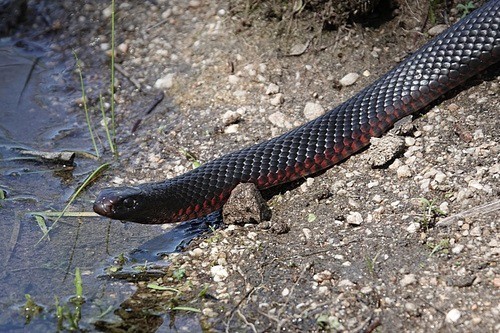
The red-bellied black snake’s realm is Australia’s east coast, with none inhabiting western or central Australia. They exist in an unbroken line running from southeast Queensland down to eastern Victoria, with Sydney and Brisbane slap bang in the middle of this range. The very endpoint of the southern ranges lies in Adelaide.
Its favourite habitat is water, but not deep water. The red-bellied black snake isn’t an underwater snake, but likes shallow areas such as swamps, lagoons, billabongs, and shallow rivers. They commonly slither into towns or villages, where they usually make their bases in drainage ditches. They’re also strong swimmers, and have been witnessed holding their breath underwater for 23 minutes before.
This snake can sometimes be found in moist forests, amid thick patches of vegetation. Red-bellied black snakes are far from water purists, as they often slither 100 metres away from their watery lair to investigate their surroundings. Nevertheless, the next time you walk past a swamp in eastern Australia, there’s a good chance that a red-belly black is watching.
| 4 | Diet: relies heavily on frogs |
The inland taipan eats mammals exclusively, and specifically the long-haired rat. The red-bellied black snake prefers to rely on amphibians as its staple instead. This blog post followed the creation of a new a natural swamp, designed as a safe haven for endangered emerald-spotted tree frogs. Within weeks, a red-bellied black snake bullied its way in, and started hoovering up not just the frogs, but the tadpoles too.
In other circumstances, their amphibious diet turns against them. In 1935, Australia made the fatal mistake of introducing the incredibly toxic cane toad species. The plan was for them to hoover up the sugar cane beetles which were devastating crops, but the toads hopped along the ground while the beetles clung to the highest plants. Instead, the cane toads multiplied like rabbits in New South Wales, with each mother toad laying up to 30,000 eggs.
Despite being venomous themselves, the red-bellied black snake cannot eat the cane toad without rotting from the inside out, yet they still frequently do. The only Australian snake with a natural adaption to cane toads is the common keelback.
| 5 | Forced to rapidly evolve |
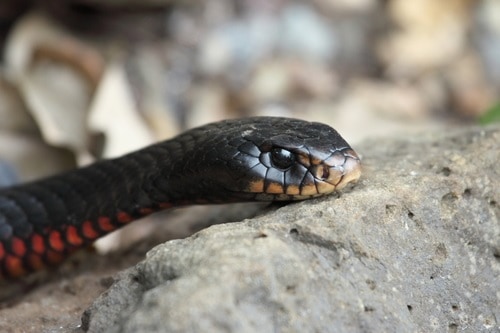
From 1935 onwards, the local red-belly population plummeted in New South Wales, while remaining steady in Queensland where the toad hadn’t fully taken over yet. The future seemed bleak, but in 2014, biologists announced an amazing discovery: that red-bellied black snakes were rapidly evolving to cope with the toxins. These new snakes seemed to eat cane toads without consistently dying, and other red-belly populations adapted in other ways.
Their heads often became smaller, physically preventing them from swallowing the 10-15cm toads. Other populations seemed to lose interest in toads altogether, focussing on their frog mainstay, as the toad-loving taste buds died out.
Following an initial plunge in New South Waves, the population of red-bellied black snakes has stabilised. The evolutionary pressure was extreme, and the snake evolved more than most other species manage in 10,000 years. The adaptions had taken place over 23 generations at the maximum. Another adaption was to lengthen their bodies; scientists had previously noticed that longer snakes coped better with the toad toxins.
| 6 | But its prey has done the same |
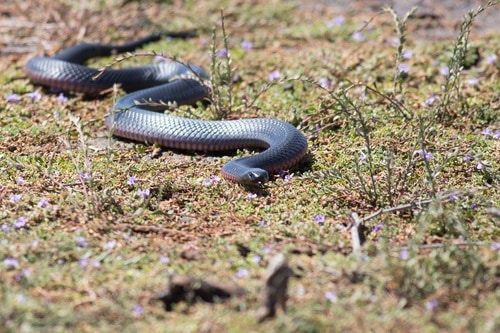
Unfortunately for the red-bellied black snake, other species have muscled in on this evolution trick. In 2021, scientists compared two of the snakes’ lizard prey, and their responses to its venom. They found that the goanna perished like any other animal, but that the blue-tongued lizard showed an unusual resistance. A protein in their bloodstream, a previously unidentified serum factor, was intercepting the proteins before they could unleash their deadly clotting action.
Fascinatingly, this venom resistance only applied to the red-bellied black snake. The scientists tested 6 other snake venoms, including small eye snake and swamp snake venom, and found no resistance among the lizards.
It’s probably down to the slow speed of the blue-tongued lizard, which forced them to evolve an alternative form of defence to fleeing. Goannas have their own special defences in the form of thick scales described as a “medieval chain mail”, which few snakes are capable of biting through. The new blue-tongued lizards still had a risk of succumbing to venom, but a dramatically reduced one.
| 7 | A manically active snake |
Red bellied black snakes are a day-faring species, which only hunts at night occasionally. Compared to the sluggish boa constrictor, they tend to be much more active, particularly during the winter months when other snakes are lazing around in underground burrows. Males can travel extremely long distances when they catch the scent of pheromones released by females; one travelled 1.22km in a single day. A male released in the wild travelled 420 metres within 24 hours.
The species has all sorts of tricks in its day to day life, including intentionally disturbing the beds of lakes to flush out prey. They’re fully capable of hunting underwater, or even hiding underwater to dodge the scanning eyes of predators. They sometimes go limp and float on the surface of lakes like a stick, to throw the predator off the scent.
Despite this manic activity, the red-bellied black snake has a snug and comfortable home range, measuring 0.02 to 40 hectares. They stay within the same general area for years and years, even retreating to the same burrows and logs at night. This is probably why they fare so well in captivity.
| 8 | Neurotoxic, but not too lethal |
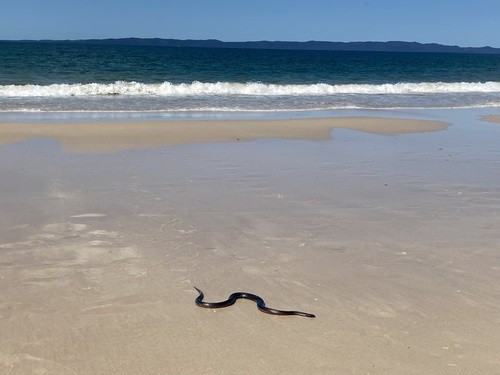
The LD50 score for red-bellied black snake venom is 2.45mg. That’s no match for the record-holding inland taipan (0.025mg), or the aggressive Chinese cobra at 0.27mg. Its venom quantity is also middling at 37mg per bite, with an all-time record of 94mg (king cobras can deliver 500mg).
The most exceptional feature is that red-belly bites are extremely painful, causing swelling, redness, rotting flesh, and general agony. In a 2010 study, scientists tested 83 red-bellied black snake bite victims, and found that 57 were injected with venom as opposed to a dry bite.
Of those, 95% suffered three or more systematic symptoms such as nausea, vomiting, headaches, abdominal pain or diarrhoea. 61% experienced anticoagulant side effects, where the blood fails to clot and open wounds bleed profusely. 16% experienced myotoxicity, or damage to muscle cells. The anticoagulant dangers were rapid, coming on within 4 hours, but the myotoxic powers were trickier and subtler. They developed only slowly, and persisted for up to 7 days. These myotoxic dangers went unnoticed for decades by biologists.
| 9 | Effective antivenom |
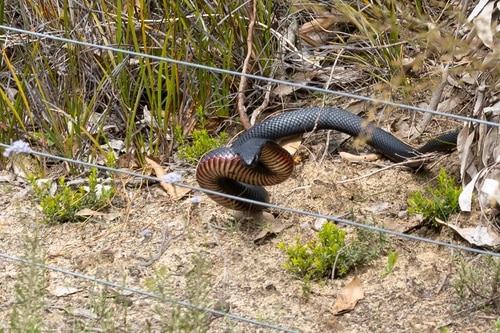
Being so common in eastern Australia, hospitals are extremely experienced with red-bellied black snake bites. A specific antivenom exists, but doctors nearly always use the cheaper tiger snake instead, which works just as well. It only takes one vial to deactivate all red-belly toxins, and if administered within 6 hours, it usually cures all symptoms.
This isn’t a nightmare snake where the clock is ticking from the very millisecond you’re bitten. It never kills people within four hours, or even 45 minutes like the dreaded Malaysian blue coral snake. In fact, the venom is too slow for the species’ own good occasionally. Red-bellied black snakes have been spotted biting frogs, before swallowing them way too quickly and being forced to spit the wriggling, thrashing amphibian back out again.
Specific toxins include the unique pseudexin, which was identified in 1981 and makes up 25% of the venom. There’s also a neurotoxin called a-elapitoxin Ppr1, but the venom itself causes no neurotoxic effects, such as trouble walking or swallowing. The toxins must be far too weak, or humans must have more resistance to them than frogs.
| 10 | Headless graveyard red-belly |
Its venom may be mild, but the red-bellied black snake has one special ability – biting people from beyond the grave. In 2010, Jake Thomas was mowing the lawns at his local churchyard with his friend Barry, as he often did around Christmas. Walking between the graves, he noticed a vase with two feet of a red-bellied black snake sticking out of it.
Being an east Australia resident, this was a perfectly common sight to Thomas. Without a second thought, he grabbed his shovel and cut the snake in half at the waist with a clean and efficient blow. He gardened for 45 more minutes, before deciding to clear the snake from public view.
He reached down to pick up his vanquished foe, but then the corpse did what he least expected – it bit him. The bodyless snake head bit Thomas twice on the hand, 45 minutes after being cut in half, causing such a sharp pain that he almost died of shock, let alone venom. The bites went deep into the flesh, later leaving a dark scar. “The bastard’s got me”, Thomas called to his friend. Thomas was driven to the hospital, where he spent two days in the ICU ward. He later claimed to be much more trusting of old folklore such as “a snake isn’t dead until sunset”.
| 11 | Versus other snakes |
Frogs form the majority of the red-bellied black snake’s menu, but recent sightings say that they won’t say no to noodles, by which we mean fellow snakes. In April 2007, in northern Queensland, scientists spotted two snake tails sticking out of a rocky den, which they identified as a red-bellied black snake measuring 1.5 metres, and a rough scaled snake measuring 1 metre. The latter is also severely venomous, triggering spontaneous bleeding, yet rarely biting people.
After one minute, the two slithered forward and emerged from the rocks. The red-belly’s mouth was fastened onto the struggling rough scaled snake, at a position just below its neck. The rough-scaled snake attempted to crawl away, but the red-bellied black snake’s jaws were locked in an iron clamp. Suddenly, the red-belly became aware of the scientists, and released its hold. The rough-scaled snake fled to the rocky shelter, its fate unknown, but probably succumbing to the venom later.
Red-bellied black snakes are also proven cannibals, as a sighting from Lamington, Queensland shows. There’s almost certainly more snake species they enjoy which are yet to be confirmed.
